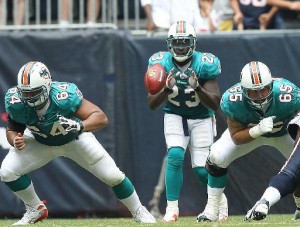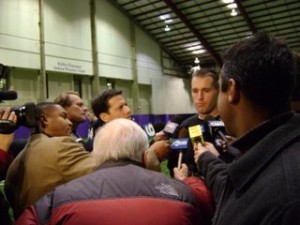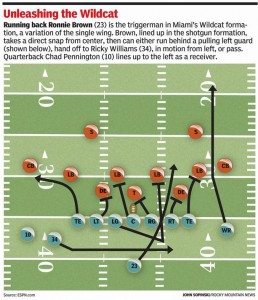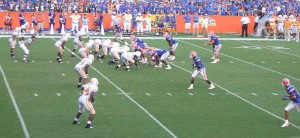By Paul M. Banks
It started with the Miami Dolphins. It spread throughout the NFL, and now into the college ranks. Syracuse has the Stallion, Indiana has the Pistol. The Northwestern Wildcats have the Wildcat? Head Coach Pat Fitzgerald was asked at his last press conference about implementing it, and of course a name for the package. Because it would be too weird and confusing to call it the Wildcat.
“Yes. Will it come up and where? I don’t know but stay tuned. I’m not that creative so we’d probably just call it some crazy formation. We usually let our guys name our packages so they can remember them so whatever’s easiest I guess. I’d rather just block people and run the ball I don’t care how we do it,” he said.
NFL teams and now FBS teams in college football are finding advantage by running unexpected plays their opponents haven’t game planned for. This is the essence of football, because in war “your opponent doesn’t prepare for what you have, he prepares for what he thinks you have. Or as Sun Tzu put it, “all warfare is based on deception.” That’s what the spread-option was- before becoming mainstream a few years ago. The spread started as a way to take a defense out of crowding the line of scrimmage and spread them out across the field into isolated match-ups. Then it becomes a matter of exploiting those one-on-one match-ups where you have a size/speed advantage.
Northwestern’s base is the spread-option (coincidentally the fight song contains the phrase “spread far the fame”) and critics of the program, and later college football in general, stated they were using gimmicks to compensate for talent discrepancy. But that’s the point!
To do the best with what you have, so those critics are idiots. It’s especially interesting to me because both the spread-option and the Wildcat have roots in the same offense: the veer. Basically, the veer looks like a Neanderthal compared to the spread-option and Wildcat. Which I guess would make the other two sets…the Italian high Renaissance.
The veer is so simplistic, it’s laughable. When I first saw the film “We are Marshall,” I laughed my ass off at one specific scene (No, not the part where everyone dies). When the coaches start rebuilding their team, their situation mandates that their scheme avoids complexity. They converse about the simplest offense around, and settle on the veer. Then they visit the legendary Bobby Bowden who is coaching at West Virginia, and running the veer, at this point.
So how I do know so much about the veer? After all, I’m not an offensive coordinator.
But I did run the offense for a week in high school. I was not my team’s quarterback in high school, but I was the perfect candidate for scout team because
1.) I was deemed expendable enough to get beat up while running the opposition’s plays on scout team.
2.) There weren’t too many honors students on our squad who could learn a new offense overnight.
So the week we prepped for Thornwood high school, I got to feel like a real QB, albeit one that our coaches wanted their players to destroy. The experience of learning, then running this offense so quickly had such an influence that it came up 9 years later. In grad school, there was a girl in my group project from that veer-running high school, and when that fact became known the first thing I said was, “your school ran such a primitive offense.” What a surprise that a great opening line like that got me nowhere!
Becoming one with the veer is a character-building experience. It’s mostly a series of option runs, option-pitches, and mainly comes down to who reaches the outside and turns the corner first. Running one side, I was able to torch one of our starting linebackers. I was less fat back then, and my full name should have been “deceptively fast” as it was the exact phrase used to describe me by pretty much everyone witnessed me on an athletic field. (See, this is why I love Deron Williams so much, announcers describe him in that manner every single game he plays)
But when I ran to the other side, looming was the state wrestling champion at the 215 weight class. That was a first class boarding pass to the pain train. I still get traumatic flashbacks. But I also painfully learned the key to stopping the veer, and the spread-option and the Wildcat for that matter- a big, fast, angry defensive end playing the game intelligently and making good reads.
Yes, the Wildcat has more draw plays and utilizes the middle quite a bit, but the days of the middle linebacker being the most important defender on the field are now over. Sure the MLB may usually be the defensive play-caller and often the emotional leader, but in today’s landscape, the end justifies the means as the most important position. And that’s why we’re seeing so many new DEs with freakish athleticism and ridiculous measurables come draft time. It’s a good old-fashioned way to neutralize the supposed quirkiness of offenses today.



